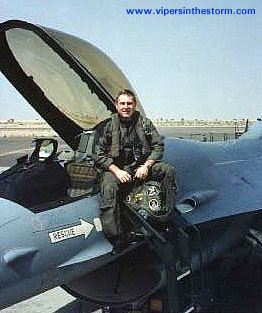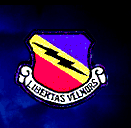Very early in my USAFA experience I had the opportunity to fly numerous orientation flights in almost all types o f Air Force aircraft. I was most impressed with the fighter aircraft mission in terms of the
challenge it presented. I was also more impressed by the attitude of the fighter pilots I met and how they viewed their mission, and their life. I just couldn't see flying a crewed aircraft where almost everything is done by a vote. Nope, I wanted to be in charge of my own destiny.
f Air Force aircraft. I was most impressed with the fighter aircraft mission in terms of the
challenge it presented. I was also more impressed by the attitude of the fighter pilots I met and how they viewed their mission, and their life. I just couldn't see flying a crewed aircraft where almost everything is done by a vote. Nope, I wanted to be in charge of my own destiny.
2) When did you join the Air Force, and what was your first flying assignment after completing Undergraduate Pilot Training?
I came to the Air Force Academy in 1967 and graduated in 1971. I immediately went to graduate school at the University of Illinois and a year later to pilot training at Webb Air Force Base in Big Spring, Texas (base closed in 1976). My first assignment following pilot training was as a T-37 Instructor Pilot at Webb. I hadn't done very well on my first T-38 checkride and there weren't many fighter assignments for my pilot
training class so I took the T-37 knowing that I would stand another chance at a fighter assignment later. If I had gone to another type of aircraft, my chances for a fighter assignment would've been drastically reduced.
3) What aircraft have you flown, and what are the different bases you have been assigned to during your Air Force career?
I have flown the T-37 at Webb AFB, TX. The T-38/AT-38 at Holloman
AFB, NM. The F-4 at MacDill AFB, FL, Kadena AB, Okinawa, Luke AFB, AZ, and Kunsan AB, ROK. The F-16 at Hill AFB, UT, Kunsan AB, Korea, Luke AFB, AZ, Al Minhad AB, UAE and Dharhan AB, Saudi Arabia.
4) Which models of the F-16 have you flown, and how many hours do you have in the Viper?
I have two thousand - five hundred hours in the F-16 and have flown every model of the F-16 from Block 1 to Block 50. I flew both the Block 40 and Block 50 in combat.
5) What was your best assignment and why?
Undoubtedly my assignment as the Commander of the 421st Fighter Squadron during Operation DESERT STORM was my best assignment. Being with your comrades in combat brings you closer together than any other experience in the world. Although most fighter pilots won't admit it.
6) This year marks the ten year anniversary of Iraq's invasion of Kuwait and the beginning of Operation Desert Shield/Storm.
Looking back, what was the experience of combat like for you?
I had actually seen combat for the first time as a cadet at the Air Force Academy. Just prior to my first class (senior) year, I was selected to spend the summer with a fighter wing at Phu Cat AB, Vietnam. Though I wasn't suppose to, the wing commander allowed me to fly several combat missions in the F-4, O-2 and EC-47. For me combat was a
learning experience. By that I mean you learn how you, and others, respond to the realization that you might lose your life. For me, combat redefined true bravery. I used to think being brave meant not being afraid. That's just not so. Anyone in their right mind will be frightened when someone else shoots at you. If they aren't afraid, then they bear careful watching. No, true bravery is still doing the mission (your job) even though you're afraid.
7) How many combat missions did you fly, and is there one particular mission that stands out more than any other?
I have flown a total of just over 100 combat missions in Vietnam, DESERT STORM and Southern Watch. My most memorable mission was undoubtedly the 388th Fighter Wing's second mission to Iraq's Nuclear Research Facility. We had already flown there once before and it was unquestionably the scariest mission of the entire war and now we
had to go back to the same target and I was the overall mission commander.
8) What do you remember most about your time spent in the United Arab Emirates at Al Minhad AB?
The absolute graciousness of our hosts and how they would sacrifice their own personal comfort to give us the best they had in terms of food, buildings, communications gear, whatever. I made some very close friends among the Emirate pilots and have had one family actually visit me since the war.
9) What have you been doing since the war, and where are you now?
After DESERT STORM I returned to Hill AFB, UT and then went to the Pentagon. Following the Pentagon I went to be the Operations Group Commander at Dharhan, AB in Saudi Arabia and flying the F-16 in combat once again. A year later I came here to the Air Force Academy where I'll remain until my retirement in June of 2000.




 f Air Force aircraft. I was most impressed with the fighter aircraft mission in terms of the
challenge it presented. I was also more impressed by the attitude of the fighter pilots I met and how they viewed their mission, and their life. I just couldn't see flying a crewed aircraft where almost everything is done by a vote. Nope, I wanted to be in charge of my own destiny.
f Air Force aircraft. I was most impressed with the fighter aircraft mission in terms of the
challenge it presented. I was also more impressed by the attitude of the fighter pilots I met and how they viewed their mission, and their life. I just couldn't see flying a crewed aircraft where almost everything is done by a vote. Nope, I wanted to be in charge of my own destiny.